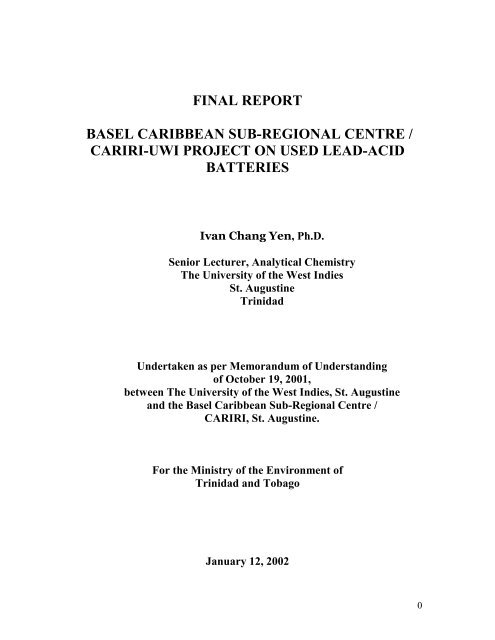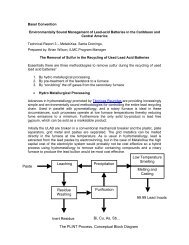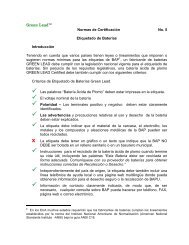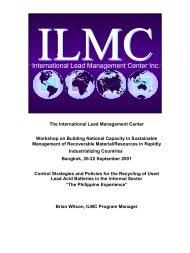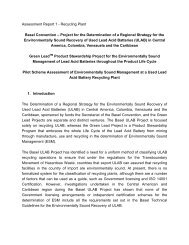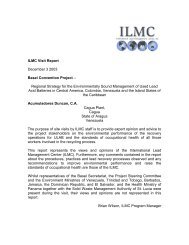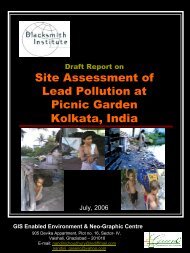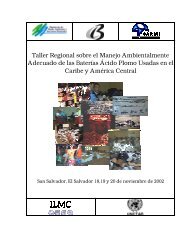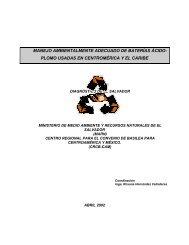Final Report on Lead-Acid Battery Recycling in T&T.pdf - the ...
Final Report on Lead-Acid Battery Recycling in T&T.pdf - the ...
Final Report on Lead-Acid Battery Recycling in T&T.pdf - the ...
Create successful ePaper yourself
Turn your PDF publications into a flip-book with our unique Google optimized e-Paper software.
FINAL REPORT<br />
BASEL CARIBBEAN SUB-REGIONAL CENTRE /<br />
CARIRI-UWI PROJECT ON USED LEAD-ACID<br />
BATTERIES<br />
Ivan Chang Yen, Ph.D.<br />
Senior Lecturer, Analytical Chemistry<br />
The University of <strong>the</strong> West Indies<br />
St. August<strong>in</strong>e<br />
Tr<strong>in</strong>idad<br />
Undertaken as per Memorandum of Understand<strong>in</strong>g<br />
of October 19, 2001,<br />
between The University of <strong>the</strong> West Indies, St. August<strong>in</strong>e<br />
and <strong>the</strong> Basel Caribbean Sub-Regi<strong>on</strong>al Centre /<br />
CARIRI, St. August<strong>in</strong>e.<br />
For <strong>the</strong> M<strong>in</strong>istry of <strong>the</strong> Envir<strong>on</strong>ment of<br />
Tr<strong>in</strong>idad and Tobago<br />
January 12, 2002<br />
0
jugaultv@unep.ch<br />
List of C<strong>on</strong>tents<br />
C<strong>on</strong>tents<br />
Page<br />
I. EXECUTIVE SUMMARY 2<br />
II. BACKGROUND 5<br />
III.<br />
IV.<br />
MACRO-ECONOMIC AND<br />
LEGAL CHARACTERISTICS 8<br />
COLLECTION, STORAGE, TRANSPORT AND<br />
RECYCLING PRACTICES FOR DISCARDED<br />
LEAD-ACID BATTERIES IN TRINIDAD<br />
AND TOBAGO 15<br />
V. CONCLUSIONS AND RECOMMENDATIONS FOR<br />
A NATIONAL PLAN OF ACTION 24<br />
VI. BIBLIOGRAPHY 27<br />
VII. ACKNOWLEDGEMENTS 28<br />
VIII. APPENDIX 29<br />
1
I – EXECUTIVE SUMMARY<br />
The problems caused by discarded lead-acid battery wastes 1 and lead smelter wastes <strong>in</strong><br />
Tr<strong>in</strong>idad 2,3 and <strong>in</strong> Jamaica 4,5 are well recognized. In most cases, ignorance of <strong>the</strong> toxic<br />
effects caused by excessive exposure to lead resulted <strong>in</strong> many cases of childhood lead<br />
pois<strong>on</strong><strong>in</strong>g. In Tr<strong>in</strong>idad, two fatalities and over 70 hospitalized cases 1, 2 were reported.<br />
The latter cases, while produc<strong>in</strong>g <strong>in</strong>itial resp<strong>on</strong>ses by local health and envir<strong>on</strong>mental<br />
authorities, have not been translated <strong>in</strong>to susta<strong>in</strong>ed acti<strong>on</strong> to prevent fur<strong>the</strong>r <strong>in</strong>cidents.<br />
<strong>Lead</strong> polluti<strong>on</strong> c<strong>on</strong>t<strong>in</strong>ues, <strong>in</strong> spite of recogniti<strong>on</strong> by <strong>the</strong> Government of Tr<strong>in</strong>idad and<br />
Tobago, of c<strong>on</strong>t<strong>in</strong>ued lead polluti<strong>on</strong> of unknown magnitude at o<strong>the</strong>r sites 6 .<br />
Activities <strong>in</strong>volv<strong>in</strong>g <strong>the</strong> repair and recycl<strong>in</strong>g of lead-acid batteries have been identified as<br />
major c<strong>on</strong>tributors to lead polluti<strong>on</strong> at many sites <strong>in</strong> Tr<strong>in</strong>idad 8 . Similarly, <strong>the</strong> storage of<br />
discarded batteries around homes and workplaces has resulted <strong>in</strong> large amounts of lead<br />
be<strong>in</strong>g accumulated <strong>in</strong> places readily accessible to young children. The system used for <strong>the</strong><br />
recycl<strong>in</strong>g of discarded lead-acid batteries is largely <strong>in</strong>effective and presents a significant<br />
risk to <strong>the</strong> health of <strong>the</strong> local populati<strong>on</strong>, and particularly young children, who are most<br />
susceptible to <strong>the</strong> toxic effects of lead 7,8 .<br />
This project had as its major objectives <strong>the</strong> follow<strong>in</strong>g:<br />
The estimati<strong>on</strong> of <strong>the</strong> number of lead-acid batteries discarded annually by<br />
automobiles <strong>in</strong> Tr<strong>in</strong>idad and Tobago;<br />
The evaluati<strong>on</strong> of <strong>the</strong> practices and identificati<strong>on</strong> of <strong>the</strong> deficiencies <strong>in</strong> <strong>the</strong> present<br />
recycl<strong>in</strong>g system;<br />
Provisi<strong>on</strong> of recommendati<strong>on</strong>s for improvement of <strong>the</strong> battery recycl<strong>in</strong>g system,<br />
based <strong>on</strong> <strong>in</strong>formati<strong>on</strong> and data collected.<br />
Informati<strong>on</strong> and data for <strong>the</strong> project were ga<strong>the</strong>red <strong>in</strong> a desktop study, us<strong>in</strong>g <strong>in</strong>formati<strong>on</strong><br />
and data from official sources. Field visits were also made to a number of battery sales,<br />
repair and recycl<strong>in</strong>g sites <strong>in</strong> both Tr<strong>in</strong>idad and Tobago, to provide <strong>in</strong>formati<strong>on</strong> <strong>on</strong> current<br />
repair, recycl<strong>in</strong>g and disposal practices.<br />
In additi<strong>on</strong>, a survey of <strong>the</strong> local adult populati<strong>on</strong> was carried out, to determ<strong>in</strong>e <strong>the</strong>ir level<br />
of awareness of, and <strong>the</strong>ir attitudes towards <strong>the</strong> recycl<strong>in</strong>g of discarded lead-acid batteries.<br />
This <strong>in</strong>formati<strong>on</strong> was c<strong>on</strong>sidered essential <strong>in</strong> determ<strong>in</strong><strong>in</strong>g <strong>the</strong> most appropriate strategy<br />
for <strong>the</strong> recycl<strong>in</strong>g of discarded batteries <strong>in</strong> <strong>the</strong> country.<br />
Our study has shown that, of <strong>the</strong> 160,000-170,000 batteries estimated to be discarded<br />
annually <strong>in</strong> Tr<strong>in</strong>idad and Tobago, most are collected by <strong>the</strong> <strong>in</strong>formal sector, and returned<br />
to a s<strong>in</strong>gle recycl<strong>in</strong>g company <strong>in</strong> east Tr<strong>in</strong>idad, for export to Venezuela.<br />
2
However, given our <strong>in</strong>ability to differentiate between new and discarded lead-acid<br />
batteries that are imported and exported from trade data, it is difficult to estimate <strong>the</strong><br />
quantity of batteries that rema<strong>in</strong> uncollected. In additi<strong>on</strong>, many totally knocked down<br />
(TKD) foreign-used vehicles imported for subsequent assembly locally, are usually<br />
classified as automobile parts and often <strong>in</strong>clude batteries which are likely to have short<br />
lifetimes (50% of resp<strong>on</strong>dents know little of<br />
<strong>the</strong> envir<strong>on</strong>mental or health effects of used lead-acid batteries, although >40% of<br />
resp<strong>on</strong>dents came <strong>in</strong>to regular c<strong>on</strong>tact with batteries (><strong>on</strong>ce/week). Most resp<strong>on</strong>dents<br />
(67%) disposed of <strong>the</strong>ir batteries by giv<strong>in</strong>g <strong>the</strong>m to recyclers or dispos<strong>in</strong>g of <strong>the</strong>m<br />
toge<strong>the</strong>r with domestic wastes, with 15% sell<strong>in</strong>g <strong>the</strong>m to recyclers, and 17% stor<strong>in</strong>g <strong>the</strong>m<br />
around <strong>in</strong> and around homes.<br />
<strong>Recycl<strong>in</strong>g</strong> of batteries was str<strong>on</strong>gly recommended, with 58% preferr<strong>in</strong>g an <strong>in</strong>centive, as<br />
aga<strong>in</strong>st 45% for a penalty, to encourage / force <strong>the</strong> return of used lead-acid batteries.<br />
However, a majority (60%) simply wanted to get rid of <strong>the</strong> batteries, 32% for<br />
envir<strong>on</strong>mental reas<strong>on</strong>s. Few resp<strong>on</strong>dents (< 7%) were aware of any public educati<strong>on</strong><br />
programme or <strong>in</strong>centive systems for recycl<strong>in</strong>g of lead-acid batteries.<br />
What is clearly needed is a susta<strong>in</strong>ed public educati<strong>on</strong>al campaign <strong>on</strong> <strong>the</strong> hazards posed<br />
by lead-acid batteries to occupati<strong>on</strong>al, public and envir<strong>on</strong>mental health. A more efficient<br />
system of collecti<strong>on</strong> and recycl<strong>in</strong>g of discarded lead-acid batteries is also urgently<br />
required, to prevent <strong>the</strong>ir accumulati<strong>on</strong> at locati<strong>on</strong>s accessible to young children and<br />
livestock. In additi<strong>on</strong>, sites that have been used for battery repair and recycl<strong>in</strong>g are likely<br />
to be extensively polluted and require envir<strong>on</strong>mental assessment and remediati<strong>on</strong>.<br />
These measures are urgently and simultaneously required, to prevent fur<strong>the</strong>r problems of<br />
lead polluti<strong>on</strong> and pois<strong>on</strong><strong>in</strong>g. It will also prevent unnecessary suffer<strong>in</strong>g <strong>in</strong> sectors of <strong>the</strong><br />
populati<strong>on</strong> that are least able to protect <strong>the</strong>mselves.<br />
3
II- BACKGROUND.<br />
BATTERY RECYCLING ACTIVITIES:<br />
PRACTICES AND DEFICIENCIES<br />
(a) Collecti<strong>on</strong> / <strong>Recycl<strong>in</strong>g</strong> Systems for Discarded <strong>Lead</strong>-<strong>Acid</strong> Batteries:<br />
<strong>Lead</strong>-acid battery collecti<strong>on</strong> for recycl<strong>in</strong>g <strong>in</strong> Tr<strong>in</strong>idad and Tobago is still largely carried<br />
out by <strong>the</strong> <strong>in</strong>formal sector, <strong>in</strong> collaborati<strong>on</strong> with a s<strong>in</strong>gle formal recycl<strong>in</strong>g company <strong>in</strong><br />
East Tr<strong>in</strong>idad (Automotive Comp<strong>on</strong>ents Ltd. or ACL). Whole discarded lead-acid<br />
batteries, lead scrap from battery repair shops and lead wastes from ACL’s own waste<br />
streams are plastic-wrapped and exported <strong>on</strong> pallets <strong>in</strong> sealed c<strong>on</strong>ta<strong>in</strong>ers, to a recycl<strong>in</strong>g<br />
company <strong>in</strong> Venezuela. ACL is also <strong>the</strong> sole manufacturer of lead-acid batteries <strong>in</strong><br />
Tr<strong>in</strong>idad and Tobago and exports many of its products to o<strong>the</strong>r Caribbean countries and<br />
<strong>the</strong> U.K.<br />
Unfortunately, many discarded batteries are not collected for recycl<strong>in</strong>g and rema<strong>in</strong> stored<br />
<strong>in</strong> and around homes and workplaces for many years, often eventually to be discarded<br />
al<strong>on</strong>g with domestic garbage <strong>in</strong> local landfills. However, it is estimated that thousands of<br />
discarded batteries still rema<strong>in</strong> stored around many households and workplaces <strong>in</strong><br />
Tr<strong>in</strong>idad.<br />
In Tr<strong>in</strong>idad, most discarded batteries are collected at <strong>the</strong> landfill sites by salvagers for<br />
return to ACL. In c<strong>on</strong>trast, <strong>in</strong> Tobago, some batteries are returned to battery sales outlets,<br />
for return to Tr<strong>in</strong>idad by ACL’s agents, while <strong>the</strong> rest rema<strong>in</strong> <strong>in</strong> storage or are discarded<br />
with domestic garbage. However, unlike <strong>in</strong> Tr<strong>in</strong>idad, <strong>the</strong> bulk of <strong>the</strong>se batteries at <strong>the</strong><br />
landfill site are buried <strong>on</strong> site, rais<strong>in</strong>g fears of subsequent leach<strong>in</strong>g of lead <strong>in</strong>to<br />
groundwater supplies.<br />
(b) Public Awareness of and Attitudes Towards <strong>Recycl<strong>in</strong>g</strong> of <strong>Lead</strong>- acid<br />
Batteries:<br />
The f<strong>in</strong>d<strong>in</strong>gs of our Attitudes and Awareness survey (Appendix I) may be summarized as<br />
follows:<br />
(i) Of <strong>the</strong> 201 adults sampled (70% males: 30% females), two thirds were employed <strong>in</strong><br />
n<strong>on</strong>-technical posts, and with less than sec<strong>on</strong>dary school educati<strong>on</strong>.<br />
(ii) Although 41% of resp<strong>on</strong>dents came <strong>in</strong>to regular c<strong>on</strong>tact (><strong>on</strong>ce / week) with batteries,<br />
>50% knew little of <strong>the</strong> envir<strong>on</strong>mental or human health risks posed by discarded lead<br />
acid batteries.<br />
(iii) Most resp<strong>on</strong>dents (67%) disposed of <strong>the</strong>ir batteries by giv<strong>in</strong>g <strong>the</strong>m to recyclers, or<br />
dispos<strong>in</strong>g of <strong>the</strong>m al<strong>on</strong>g with domestic garbage, with 15% sell<strong>in</strong>g <strong>the</strong>m to recyclers and<br />
17% stor<strong>in</strong>g <strong>the</strong>m <strong>in</strong> and around homes.<br />
4
(iv) Many resp<strong>on</strong>dents were <strong>in</strong> str<strong>on</strong>g agreement with a recycl<strong>in</strong>g programme, with 58%<br />
preferr<strong>in</strong>g a f<strong>in</strong>ancial <strong>in</strong>centive, as aga<strong>in</strong>st 45% for a penalty, to encourage / force <strong>the</strong><br />
return of discarded batteries.<br />
However, 60% simply wanted to get rid of <strong>the</strong> batteries, with 32% express<strong>in</strong>g c<strong>on</strong>cerns<br />
for envir<strong>on</strong>mental polluti<strong>on</strong> by discarded batteries.<br />
(v) Few (
Ventilati<strong>on</strong> was unregulated and no atmospheric filtrati<strong>on</strong> systems were evident. Wash<strong>in</strong>g<br />
and waste effluents were also c<strong>on</strong>nected to domestic waste effluent systems and work<br />
clo<strong>the</strong>s were normally laundered with o<strong>the</strong>r family members’ clo<strong>the</strong>s. Not surpris<strong>in</strong>gly,<br />
n<strong>on</strong>e of <strong>the</strong> workers surveyed acknowledged ever hav<strong>in</strong>g a blood lead analysis d<strong>on</strong>e,<br />
ei<strong>the</strong>r due to lack of knowledge of <strong>the</strong> importance of blood lead test<strong>in</strong>g, and/or no ready<br />
access to this service.<br />
In c<strong>on</strong>trast, our visit to Automotive Comp<strong>on</strong>ents Ltd.’s battery manufactur<strong>in</strong>g and<br />
recycl<strong>in</strong>g plant showed clear evidence of use of protective gear (shoes, dust masks, hard<br />
hats, goggles) and dust filtrati<strong>on</strong> systems <strong>in</strong> <strong>the</strong> plant. Separate shower and clo<strong>the</strong>s<br />
wash<strong>in</strong>g facilities were also provided, to m<strong>in</strong>imize <strong>the</strong> transfer of lead from <strong>the</strong><br />
workplace to homes. Blood lead m<strong>on</strong>itor<strong>in</strong>g of employees, al<strong>on</strong>g with exam<strong>in</strong>ati<strong>on</strong>s by<br />
<strong>the</strong> company’s doctor are part of <strong>the</strong> company’s stated policy <strong>on</strong> occupati<strong>on</strong>al health and<br />
safety. Plant waste effluent were reported to be c<strong>on</strong>trolled, although we did not view this<br />
aspect of <strong>the</strong> plant’s operati<strong>on</strong>s.<br />
It is clear that <strong>the</strong> <strong>in</strong>formal sector requires a great deal of improvement <strong>in</strong> occupati<strong>on</strong>al<br />
and envir<strong>on</strong>mental health practices, to m<strong>in</strong>imize <strong>the</strong>ir impact <strong>on</strong> <strong>the</strong> surround<strong>in</strong>g<br />
envir<strong>on</strong>ments and <strong>the</strong> health of <strong>the</strong>ir <strong>in</strong>habitants. Provisi<strong>on</strong> of educati<strong>on</strong>al material and<br />
blood lead test<strong>in</strong>g facilities, toge<strong>the</strong>r with envir<strong>on</strong>mental m<strong>on</strong>itor<strong>in</strong>g by local regulatory<br />
authorities, can help this sector to protect its own health and envir<strong>on</strong>ment.<br />
Occupati<strong>on</strong>al and envir<strong>on</strong>mental health standards should be implemented and enforced,<br />
to c<strong>on</strong>trol lead polluti<strong>on</strong> from battery repair, recycl<strong>in</strong>g and manufactur<strong>in</strong>g operati<strong>on</strong>s.<br />
Such standards will also reduce <strong>the</strong> risk to <strong>the</strong> health of <strong>the</strong> families of <strong>the</strong> recyclers, who<br />
often live <strong>in</strong> close proximity to <strong>the</strong>se operati<strong>on</strong>s.<br />
6
III - MACRO-ECONOMIC AND LEGAL CHARACTERISTICS<br />
(a) <strong>Battery</strong>-Related Nati<strong>on</strong>al Supply and Demand.<br />
In order to estimate <strong>the</strong> number of batteries generated annually for recycl<strong>in</strong>g <strong>in</strong> Tr<strong>in</strong>idad<br />
and Tobago, and <strong>the</strong> numbers imported and exported, a desktop study was c<strong>on</strong>ducted to<br />
collect data from <strong>the</strong> follow<strong>in</strong>g sources:<br />
The Central Statistical Office, M<strong>in</strong>istry of Integrated Plann<strong>in</strong>g and Development;<br />
Licens<strong>in</strong>g Office, M<strong>in</strong>istry of Transport;<br />
Automotive Comp<strong>on</strong>ents Limited; Sole Manufacturer and Formal Recycler of<br />
<strong>Lead</strong>-<strong>Acid</strong> Batteries <strong>in</strong> Tr<strong>in</strong>idad and Tobago; Neal and Massy Co. Ltd.;<br />
A survey of local motor vehicle owners to estimate <strong>the</strong> average lifetime of<br />
batteries locally, and <strong>the</strong>ir average changeover time;<br />
Customs and Excise Divisi<strong>on</strong>, M<strong>in</strong>istry of F<strong>in</strong>ance.<br />
The quantities of lead-acid batteries generated and recycled annually were calculated<br />
from <strong>the</strong> follow<strong>in</strong>g data:<br />
Motor vehicles licensed annually;<br />
New and foreign-used vehicles licensed annually;<br />
Average lifetime of automobile batteries locally;<br />
Year when battery last changed.<br />
7
(b) Results of Desktop Study:<br />
Table 1.<br />
Vehicles Licensed for Tr<strong>in</strong>idad and Tobago.<br />
Type of Vehicle Licensed No. of Vehicles Total # of<br />
(# Batteries per vehicle) Batteries<br />
1999 Motorcycle 2,860 (1) 715*<br />
Private 196,105 (1) 196,105<br />
Rented 7,026 (1) 7,026<br />
Hired 25,814 (1) 25,814<br />
Goods (light trucks) 49,649 (1) 49,649<br />
Tractors 3,978 (1) 3,978<br />
Omnibus 317 (2) 634<br />
Industrial 458 (2) 916<br />
Total # of Batteries 284,837<br />
New Vehicles Licensed 9,976 (1) 9,976<br />
Foreign-Used Vehicles<br />
Licensed 8,598 (1) 8,598<br />
2000 Motorcycle 3,033 (1) 758*<br />
Private 214,139 (1) 214,139<br />
Rented 7,463 (1) 7,463<br />
Hired 26,922 (1) 26,922<br />
Goods (light trucks) 52,277 (1) 52,277<br />
Tractors 4,206 (1) 4,206<br />
Omnibus 350 (2) 700<br />
Industrial 539 (2) 1,078<br />
Total # of Batteries 307,543<br />
New Vehicles Licensed 16,286 (1) 16,286<br />
Foreign-Used Vehicles<br />
Licensed 8,516 (1) 8,516<br />
*1 motorcycle battery ~ 0.25 mass of typical automotive battery<br />
8
(c) Annual Estimates of Batteries For <strong>Recycl<strong>in</strong>g</strong> <strong>in</strong> Tr<strong>in</strong>idad and Tobago.<br />
Total # of Used <strong>Lead</strong>-<strong>Acid</strong> Batteries Estimated to be Recycled Annually is Calculated as<br />
Follows:<br />
Based <strong>on</strong> data obta<strong>in</strong>ed from survey of local populati<strong>on</strong> <strong>on</strong>:<br />
(i) Average lifetimes of automobiles batteries by users<br />
2 years for new cars.<br />
1 year for foreign-used car.<br />
(ii) Last year of change of battery from vehicle:<br />
Approximately 50% of registered vehicles replace batteries each year.<br />
Estimated Total Batteries to be Recycled per Annum:<br />
From New Vehicles 2 years prior to recycl<strong>in</strong>g year + Foreign-Used Vehicles 1 year<br />
prior to recycl<strong>in</strong>g year + 50% of Registered Vehicles1 year prior to recycl<strong>in</strong>g year.<br />
In Year 2000:<br />
Estimated # of batteries for recycl<strong>in</strong>g:<br />
9500 (est.) + 8598 + (0.5 x 284,837) = 160,517 units.<br />
At an average of 42 wt. % Pb (as Metallic + Pb compounds) per battery,<br />
@ 11.5 kg each*, total lead c<strong>on</strong>tent for recycl<strong>in</strong>g = 775,297 kg Pb<br />
In Year 2001:<br />
Estimated # of batteries for recycl<strong>in</strong>g:<br />
9976 + 8516 + (0.5 x 307,543) = 172,264 units.<br />
At an average of 42 wt. % Pb (as Metallic + Pb compounds) per battery,<br />
@ 11.5 kg* each, total lead c<strong>on</strong>tent for recycl<strong>in</strong>g = 832,035 kg Pb<br />
* Mean of analyses of four dissected lead-acid batteries.<br />
9
(d) Imports <strong>in</strong>to and Exports of Batteries from Tr<strong>in</strong>idad and Tobago:<br />
The data obta<strong>in</strong>ed from <strong>the</strong> Customs and Excise Divisi<strong>on</strong> and from Automotive<br />
Comp<strong>on</strong>ents Ltd. respectively were as follows:<br />
Table 2.<br />
<strong>Battery</strong> Imports and Exports for Tr<strong>in</strong>idad and Tobago.<br />
Year # <strong>Lead</strong>-<strong>Acid</strong> Batteries # <strong>Lead</strong>-<strong>Acid</strong> Batteries<br />
Imported /kg<br />
Exported /kg<br />
(Equivalent <strong>Battery</strong> Units*) (Equivalent <strong>Battery</strong> Units*)<br />
1999<br />
672,404 (58,470) 3,138,033 (272,872)<br />
2000<br />
670,917 (58,341) 3,327,020 (289,306)<br />
*Assume 1 <strong>Battery</strong> Unit = 11.5kg<br />
Table 3.<br />
Local Sales of Locally Manufactured <strong>Lead</strong> <strong>Acid</strong> Batteries and Exports of<br />
Used <strong>Lead</strong>-<strong>Acid</strong> Batteries by <strong>the</strong> Sole Manufacturer and Formal Recycler<br />
<strong>in</strong> Tr<strong>in</strong>idad and Tobago.<br />
Two-Year Annual Average of Scrap <strong>Battery</strong> Exports:<br />
2,280,000 kg<br />
At 11.5kg per <strong>Battery</strong> Unit, Equivalent # of Units Exported = 198,261<br />
Local <strong>Battery</strong> Sales 75,000 Units .<br />
The number of battery units officially exported thus exceeds <strong>the</strong> number estimated for<br />
recycl<strong>in</strong>g annually by about 26,000-38,000 units for years 2000 and 1999 respectively,<br />
represent<strong>in</strong>g an underestimati<strong>on</strong> by 17-19%. Such underestimati<strong>on</strong> may be due to <strong>the</strong><br />
average battery mass of 11.5kg used be<strong>in</strong>g too high, as well as to <strong>the</strong> recycl<strong>in</strong>g of<br />
batteries imported with TKD vehicles, for which no accurate estimate was possible.<br />
10
The periodic disposal for recycl<strong>in</strong>g of stored discarded batteries by householders and<br />
bus<strong>in</strong>esses may also c<strong>on</strong>tribute to this difference.<br />
In comparis<strong>on</strong>, <strong>the</strong> number of battery units officially exported exceeds ACL’s mean<br />
annual scrap battery exports by about 75,000-90,000 units. This is assumed to represent<br />
<strong>the</strong> number of new batteries exported by ACL.<br />
The system of classificati<strong>on</strong> of batteries used by <strong>the</strong> Customs and Excise <strong>the</strong>refore<br />
requires revisi<strong>on</strong>, to allow used and new batteries to be differentiated, as required under<br />
<strong>the</strong> Basel C<strong>on</strong>venti<strong>on</strong>.<br />
(e) Collecti<strong>on</strong>, Storage, Transport and <strong>Recycl<strong>in</strong>g</strong> of Discarded <strong>Lead</strong>-<strong>Acid</strong><br />
Batteries <strong>in</strong> Tr<strong>in</strong>idad and Tobago.<br />
A survey was c<strong>on</strong>ducted at automobile parts sales outlets around Tr<strong>in</strong>idad and Tobago.<br />
Of <strong>the</strong> 296 retail outlets listed <strong>in</strong> <strong>the</strong> local teleph<strong>on</strong>e directory, a statistically<br />
representative and randomly selected sample (132) <strong>in</strong> both islands was visited. These<br />
c<strong>on</strong>sisted of sites <strong>in</strong> north (65), south (37) and central (24) Tr<strong>in</strong>idad and Tobago (6).<br />
Informati<strong>on</strong> <strong>on</strong> <strong>the</strong>ir sales and collecti<strong>on</strong> of used batteries for recycl<strong>in</strong>g was obta<strong>in</strong>ed, as<br />
per questi<strong>on</strong>naire <strong>in</strong> Appendix II.<br />
Only 41 (31%) of <strong>the</strong> 132 outlets <strong>in</strong> Tr<strong>in</strong>idad and Tobago collected discarded batteries<br />
from <strong>the</strong>ir customers, with <strong>the</strong> follow<strong>in</strong>g # of batteries collected by <strong>the</strong> comb<strong>in</strong>ed outlets.<br />
A summary of <strong>the</strong> f<strong>in</strong>d<strong>in</strong>gs from <strong>the</strong> 41 outlets is as follows:<br />
Table 4.<br />
Automobile Parts and <strong>Battery</strong> Sales Retail Outlets.<br />
# batteries collected/week # (%) of outlets Total # batteries<br />
collected/week<br />
1-6 28 (68.3) 28-168<br />
6-11 8 (19.5) 48-88<br />
20-25 2 (4.9) 40-50<br />
30 2 (4.9) 60<br />
50 1 (2.4) 50<br />
11
Assum<strong>in</strong>g that <strong>the</strong> outlets are representative of <strong>the</strong> total (296) outlets, it can be<br />
extrapolated that 83 outlets collect batteries for recycl<strong>in</strong>g <strong>in</strong> Tr<strong>in</strong>idad. From <strong>the</strong>se,<br />
between 226-416 batteries are collected per week, or 11,300-20,800 per annum, for a 50-<br />
week work<strong>in</strong>g year.<br />
It is obvious that automobile and battery sales outlets collect <strong>on</strong>ly a small fracti<strong>on</strong><br />
(7-13%) of an estimated 165,000 batteries estimated for recycl<strong>in</strong>g annually. This estimate<br />
appears to fall with<strong>in</strong> <strong>the</strong> regi<strong>on</strong> of exports of new batteries by Automotive Comp<strong>on</strong>ents<br />
Ltd.<br />
(f) <strong>Battery</strong> Repair and <strong>Recycl<strong>in</strong>g</strong> Operati<strong>on</strong>s:<br />
In order to estimate <strong>the</strong> role of battery repair and recycl<strong>in</strong>g operators, <strong>on</strong>ly a few of whom<br />
are licensed scrap metal dealers, with <strong>the</strong> rest <strong>in</strong> <strong>the</strong> <strong>in</strong>formal sector, a survey was<br />
undertaken of as many of <strong>the</strong>se sites as could be located. S<strong>in</strong>ce local licensed scrap metal<br />
dealers operate under m<strong>in</strong>imal supervisi<strong>on</strong> from local health authorities, <strong>the</strong>se are<br />
<strong>in</strong>cluded under <strong>the</strong> <strong>in</strong>formal sector. Only 8 of 15 sites identified <strong>in</strong> previous report were<br />
located and visited <strong>in</strong> Tr<strong>in</strong>idad and Tobago to date. The number of batteries reported to<br />
be collected are shown <strong>in</strong> Table 4.<br />
A summary of <strong>the</strong>se f<strong>in</strong>d<strong>in</strong>gs are as follows:<br />
Table 5.<br />
<strong>Battery</strong> Repair and <strong>Recycl<strong>in</strong>g</strong> Operati<strong>on</strong>s.<br />
Locati<strong>on</strong><br />
# batteries collected /annum<br />
Sangre Grande, East Tr<strong>in</strong>idad (repair and recycl<strong>in</strong>g) 400<br />
Ft. George, West Tr<strong>in</strong>idad (repair and recycl<strong>in</strong>g) 4800<br />
Borde Narve, South Tr<strong>in</strong>idad (recycl<strong>in</strong>g <strong>on</strong>ly) 2400<br />
Eastern Ma<strong>in</strong> Road, Laventille, Tr<strong>in</strong>idad<br />
(3 sites: repair and recycl<strong>in</strong>g) 2000<br />
South Quay, Port of Spa<strong>in</strong> (recycl<strong>in</strong>g <strong>on</strong>ly) 5000<br />
Scarborough, Tobago 200<br />
From <strong>the</strong>se sources, it is estimated that 14,800 batteries/annum are collected for<br />
recycl<strong>in</strong>g. If <strong>the</strong>se 8 sites are assumed to represent <strong>the</strong> 15 sites listed as be<strong>in</strong>g used for<br />
repair and recycl<strong>in</strong>g, <strong>the</strong> total number of batteries collected by <strong>the</strong>se operati<strong>on</strong>s can be<br />
estimated at 27,750 annum or 17 % of <strong>the</strong> total batteries estimated for recycl<strong>in</strong>g annually.<br />
12
Overall, it is estimated that <strong>on</strong>ly 24-30% of all batteries recycled are d<strong>on</strong>e by <strong>the</strong><br />
operati<strong>on</strong>s surveyed. The rema<strong>in</strong><strong>in</strong>g 70-76 % (approximately 115,000-124,000 battery<br />
units) are recycled by o<strong>the</strong>r operators who were not located <strong>in</strong> our survey.<br />
Discussi<strong>on</strong>s with battery sales and service outlets <strong>in</strong>dicate that several small metal<br />
recycl<strong>in</strong>g operators regularly collect discarded batteries, for return to Automotive<br />
Comp<strong>on</strong>ents Ltd. <strong>in</strong> eastern Tr<strong>in</strong>idad, which has c<strong>on</strong>firmed this practice. It is also likely<br />
that salvag<strong>in</strong>g operati<strong>on</strong>s by small groups <strong>in</strong> <strong>the</strong> various municipal dumps <strong>in</strong> Tr<strong>in</strong>idad<br />
recycle a significant number of batteries, emphasiz<strong>in</strong>g <strong>the</strong> role of <strong>the</strong> <strong>in</strong>formal sector <strong>in</strong><br />
battery recycl<strong>in</strong>g.<br />
These f<strong>in</strong>d<strong>in</strong>gs underl<strong>in</strong>e <strong>the</strong> importance of <strong>the</strong> role of <strong>the</strong> <strong>in</strong>formal sector <strong>in</strong> lead-acid<br />
battery recycl<strong>in</strong>g (already dem<strong>on</strong>strated by <strong>the</strong> success of <strong>the</strong> glass recycl<strong>in</strong>g<br />
programme), <strong>on</strong>ce a f<strong>in</strong>ancial <strong>in</strong>centive is provided.<br />
However, based <strong>on</strong> <strong>in</strong>formati<strong>on</strong> received dur<strong>in</strong>g our attitudes and awareness survey, it is<br />
evident that many discarded batteries rema<strong>in</strong> <strong>in</strong> storage around workplaces or houses.<br />
These batteries will require a special collecti<strong>on</strong> effort to ensure <strong>the</strong>ir recycl<strong>in</strong>g at <strong>the</strong><br />
earliest opportunity.<br />
(g) Legal and Regulatory Framework:<br />
At present, legislati<strong>on</strong> govern<strong>in</strong>g lead-acid battery manufacture and repair is governed by<br />
The Electric Accumulator Act (Manufacture and Repair) Order 1974. Under this Act,<br />
blood lead m<strong>on</strong>itor<strong>in</strong>g is mandated and specific acti<strong>on</strong>s required <strong>on</strong>ce target levels are<br />
exceeded. Unfortunately, envir<strong>on</strong>mental standards are not <strong>in</strong>cluded <strong>in</strong> this Act.<br />
However, no laws specific to lead-acid battery recycl<strong>in</strong>g exist <strong>in</strong> Tr<strong>in</strong>idad and Tobago,<br />
although recently proposed legislati<strong>on</strong> is aimed at encourag<strong>in</strong>g <strong>the</strong> recycl<strong>in</strong>g of discarded<br />
products, <strong>in</strong>clud<strong>in</strong>g lead-acid batteries. Unfortunately <strong>the</strong>se proposals were not available<br />
to us, but we were <strong>in</strong>formed by <strong>the</strong> Envir<strong>on</strong>mental Management Authority that <strong>the</strong>y were<br />
submitted for parliamentary discussi<strong>on</strong> and approval. To date, no progress appears to<br />
have been made <strong>on</strong> <strong>the</strong>se proposals.<br />
13
IV - COLLECTION, STORAGE, TRANSPORT AND RECYCLING PRACTICES<br />
FOR DISCARDED LEAD-ACID BATTERIES IN TRINIDAD AND TOBAGO<br />
Data and <strong>in</strong>formati<strong>on</strong> for this phase of <strong>the</strong> study were obta<strong>in</strong>ed dur<strong>in</strong>g visits to <strong>the</strong><br />
follow<strong>in</strong>g:<br />
Envir<strong>on</strong>mental Management Authority, M<strong>in</strong>istry of <strong>the</strong> Envir<strong>on</strong>ment, Tr<strong>in</strong>idad.<br />
Fisheries Divisi<strong>on</strong>, <strong>the</strong> Tobago House of Assembly, Scarborough, Tobago.<br />
<strong>Battery</strong> Repair and <strong>Recycl<strong>in</strong>g</strong> Sites <strong>in</strong> Tr<strong>in</strong>idad and Tobago.<br />
Automobile Parts / <strong>Battery</strong> Sales Outlets <strong>in</strong> Tr<strong>in</strong>idad and Tobago.<br />
Envir<strong>on</strong>ment Tobago, a n<strong>on</strong>-governmental organizati<strong>on</strong> <strong>in</strong>volved <strong>in</strong><br />
envir<strong>on</strong>mental educati<strong>on</strong> and c<strong>on</strong>servati<strong>on</strong> <strong>in</strong> Tobago.<br />
Fishermen <strong>in</strong> Tobago.<br />
The f<strong>in</strong>d<strong>in</strong>gs of this phase of <strong>the</strong> study are summarized for <strong>the</strong> Formal and Informal<br />
Sectors respectively.<br />
IV(a): Practices <strong>in</strong> <strong>the</strong> Formal Sector:<br />
(i) <strong>Recycl<strong>in</strong>g</strong>:<br />
Only <strong>on</strong>e company sited <strong>in</strong> east Tr<strong>in</strong>idad (Automotive Comp<strong>on</strong>ents Ltd. or ACL) has<br />
been identified as a recycler of discarded lead-acid batteries <strong>in</strong> Tr<strong>in</strong>idad and Tobago. This<br />
company is also <strong>the</strong> sole manufacturer of lead-acid batteries <strong>in</strong> <strong>the</strong> country, many of<br />
which are exported to <strong>the</strong> rest of <strong>the</strong> Caribbean and <strong>the</strong> UK. This site also provides a<br />
retail sale and service facility for <strong>the</strong> company’s batteries, as well as for <strong>the</strong> return of<br />
defective batteries by c<strong>on</strong>sumers.<br />
The recycl<strong>in</strong>g area east of <strong>the</strong> battery manufactur<strong>in</strong>g plant accommodates <strong>the</strong> recepti<strong>on</strong>,<br />
storage, plastic-wrapp<strong>in</strong>g and pallet<strong>in</strong>g facilities for discarded batteries, for c<strong>on</strong>ta<strong>in</strong>erized<br />
shipment to Venezuela for recycl<strong>in</strong>g (Plate 3). Batteries are weighed and shipped upright<br />
with <strong>the</strong> acid, and <strong>the</strong> c<strong>on</strong>tributi<strong>on</strong> of <strong>the</strong> acid to <strong>the</strong> battery mass calculated.<br />
Similarly, battery plate wastes, bag-house dusts, waste effluent solids and o<strong>the</strong>r batterymanufactur<strong>in</strong>g<br />
wastes are placed <strong>in</strong> drums <strong>on</strong> pallets and plastic-wrapped <strong>on</strong> pallets for<br />
shipment with scrap batteries. Workers are provided with protective gear as previously<br />
described, and envir<strong>on</strong>mental health and safety practices appear to be observed.<br />
14
Plate 3: Scrap batteries plastic-wrapped for export to Venezuela.<br />
(ii) Envir<strong>on</strong>mental impacts:<br />
<strong>Acid</strong> spills <strong>in</strong> <strong>the</strong> battery recycl<strong>in</strong>g area are reported to be neutralized with sodium<br />
bicarb<strong>on</strong>ate and <strong>the</strong> result<strong>in</strong>g wastes flushed <strong>in</strong>to <strong>the</strong> waste dra<strong>in</strong>s. Some c<strong>on</strong>tam<strong>in</strong>ati<strong>on</strong><br />
of <strong>the</strong> site by damaged batteries was evident, but <strong>the</strong> recycl<strong>in</strong>g area was generally well<br />
ordered. Refurbish<strong>in</strong>g of <strong>the</strong> recycl<strong>in</strong>g area is planned, to m<strong>in</strong>imize envir<strong>on</strong>mental<br />
c<strong>on</strong>tam<strong>in</strong>ati<strong>on</strong> from <strong>the</strong> recycled materials.<br />
However, effluents from <strong>the</strong> site are not treated and may result <strong>in</strong> c<strong>on</strong>tam<strong>in</strong>ated effluents<br />
enter<strong>in</strong>g <strong>the</strong> general dra<strong>in</strong>age system, especially dur<strong>in</strong>g heavy ra<strong>in</strong>fall.<br />
(iii) Occupati<strong>on</strong>al health practices:<br />
As per questi<strong>on</strong>naire data <strong>in</strong> Appendix III, ACL provides safety gear for its workers and<br />
implements envir<strong>on</strong>mental health and safety policies <strong>in</strong> <strong>the</strong> manufactur<strong>in</strong>g and recycl<strong>in</strong>g<br />
areas of <strong>the</strong> plant.<br />
Respirators and dust masks are provided for all employees and are supposed to be worn<br />
dur<strong>in</strong>g manufactur<strong>in</strong>g, ma<strong>in</strong>tenance and recycl<strong>in</strong>g operati<strong>on</strong>s.<br />
Blood lead m<strong>on</strong>itor<strong>in</strong>g is d<strong>on</strong>e regularly, toge<strong>the</strong>r with exam<strong>in</strong>ati<strong>on</strong>s by <strong>the</strong> company’s<br />
medical practiti<strong>on</strong>er who, toge<strong>the</strong>r with <strong>the</strong> Plant Manager, are resp<strong>on</strong>sible for<br />
occupati<strong>on</strong>al health <strong>in</strong> <strong>the</strong> plant.<br />
15
Uniforms, chang<strong>in</strong>g facilities, lockers and showers are provided for employees, with<br />
daily wash<strong>in</strong>g of uniforms by <strong>the</strong> company.<br />
A lunch room separate from <strong>the</strong> plant is provided for employees, and wash<strong>in</strong>g of <strong>the</strong><br />
hands before meals is generally practiced.<br />
Overall, sound EHS practices appear to be <strong>the</strong> norm for this plant.<br />
(iv) Retail and collecti<strong>on</strong> of discarded batteries:<br />
On an annual basis, ACL exports an average of 2,280 metric t<strong>on</strong>es of scrap batteries to<br />
Venezuela. This is equivalent to 198,261 battery units, if an average of 11.5kg / battery is<br />
assumed.<br />
These are composed of whole and damaged batteries returned by ACL’s agents, battery<br />
recyclers <strong>in</strong> <strong>the</strong> <strong>in</strong>formal sector, as well as wastes from ACL’s battery manufactur<strong>in</strong>g<br />
plant. As described previously, batteries and lead-c<strong>on</strong>ta<strong>in</strong><strong>in</strong>g wastes are places <strong>on</strong> pallets,<br />
plastic-wrapped and placed <strong>in</strong> c<strong>on</strong>ta<strong>in</strong>ers, for shipment to Venezuela.<br />
(v) Recommendati<strong>on</strong>s for short-term improvements:<br />
The collecti<strong>on</strong> system for discarded batteries is <strong>the</strong> weakest l<strong>in</strong>k <strong>in</strong> <strong>the</strong> recycl<strong>in</strong>g system<br />
currently practiced. It is estimated that thousands of discarded batteries rema<strong>in</strong> <strong>in</strong> storage<br />
<strong>in</strong> and around homes and workplaces and pose a hazard to young children and domestic<br />
animals. A system for <strong>the</strong> mandatory return of defective batteries for recycl<strong>in</strong>g is also<br />
required as so<strong>on</strong> as possible.<br />
IV(b): Collecti<strong>on</strong> and Storage Practices <strong>in</strong> <strong>the</strong> Informal Sector:<br />
(i) <strong>Battery</strong> repair and recycl<strong>in</strong>g shops:<br />
Of <strong>the</strong> eight sites visited that were used for battery repair and recycl<strong>in</strong>g, n<strong>on</strong>e had proper<br />
storage c<strong>on</strong>diti<strong>on</strong>s for extended (>3 m<strong>on</strong>ths) storage of discarded batteries. Of <strong>the</strong>se, <strong>on</strong>ly<br />
<strong>on</strong>e had a c<strong>on</strong>crete-covered area specifically for storage of batteries, but had no<br />
c<strong>on</strong>ta<strong>in</strong>ment or neutralizati<strong>on</strong> system for spilt acid (Plate 4).<br />
16
Plate 4: Batteries for recycl<strong>in</strong>g, Borde Narve Village, S. Tr<strong>in</strong>idad.<br />
At n<strong>on</strong>e of <strong>the</strong> o<strong>the</strong>r sites was acid-neutralizati<strong>on</strong> practiced, with simple wash down with<br />
water, or no treatment at all practiced.<br />
Batteries are generally recycled with <strong>the</strong> acid, although several repair and recycl<strong>in</strong>g shops<br />
dra<strong>in</strong> and collect <strong>the</strong> acid <strong>in</strong> drums (Plate 5), for reuse <strong>in</strong> batteries that are serviced or<br />
repaired.<br />
17
Plate 5: Recycled sulfuric acid, lower Fort George Road, W. Tr<strong>in</strong>idad.<br />
In additi<strong>on</strong>, most of <strong>the</strong> batteries collected for recycl<strong>in</strong>g were stored <strong>in</strong> <strong>the</strong> open, exposed<br />
to sunlight and ra<strong>in</strong>fall. In <strong>on</strong>e case, persistent problems <strong>in</strong> obta<strong>in</strong><strong>in</strong>g transport of <strong>the</strong><br />
batteries for recycl<strong>in</strong>g results <strong>in</strong> a pileup of batteries for m<strong>on</strong>ths at a time (Plate 6).<br />
Recycled batteries are normally transported <strong>in</strong> open vehicles to <strong>the</strong> recycl<strong>in</strong>g plant <strong>in</strong> east<br />
Tr<strong>in</strong>idad, usually small trucks.<br />
18
Plate 6: Accumulated batteries for recycl<strong>in</strong>g, lower Ft. George Rd., W. Tr<strong>in</strong>idad.<br />
(ii) <strong>Battery</strong> sales outlets:<br />
At <strong>the</strong> automobile parts outlets which sell batteries, defective batteries are generally left<br />
by customers, when purchas<strong>in</strong>g new batteries. These batteries are ei<strong>the</strong>r given or sold to<br />
<strong>in</strong>formal recyclers, or are collected by ACL’s agents for return to <strong>the</strong>ir plant <strong>in</strong> east<br />
Tr<strong>in</strong>idad. At battery claim centres <strong>in</strong> Tr<strong>in</strong>idad and Tobago, defective batteries returned<br />
while still under warranty are dra<strong>in</strong>ed and <strong>the</strong>ir covers removed <strong>in</strong> “autopsy rooms”. This<br />
is d<strong>on</strong>e to establish whe<strong>the</strong>r <strong>the</strong> defect was due to a manufacturer’s problem before<br />
provid<strong>in</strong>g a replacement battery. The opened batteries are subsequently returned to <strong>the</strong><br />
company for recycl<strong>in</strong>g. Needless to say, <strong>the</strong> possibility of acid spillage and exposure of<br />
<strong>the</strong> operators to <strong>the</strong> battery plates and acid is <strong>in</strong>creased by this practice. This practice<br />
should be disc<strong>on</strong>t<strong>in</strong>ued, and <strong>on</strong>ly d<strong>on</strong>e at <strong>the</strong> factory under c<strong>on</strong>diti<strong>on</strong>s that can ensure <strong>the</strong><br />
safety of <strong>the</strong> pers<strong>on</strong>s <strong>in</strong>volved.<br />
However, many sales outlets are reluctant to encourage <strong>the</strong> return of batteries, s<strong>in</strong>ce many<br />
have limited storage space, and <strong>the</strong> sporadic collecti<strong>on</strong> of discarded batteries is<br />
<strong>in</strong>c<strong>on</strong>venient, as well as generates a health hazard.<br />
19
(iii) Envir<strong>on</strong>mental impacts:<br />
At automobile parts sales outlets, <strong>the</strong> envir<strong>on</strong>mental problems due to <strong>the</strong> collecti<strong>on</strong> of<br />
discarded lead-acid batteries are generally m<strong>in</strong>imal. However, c<strong>on</strong>tam<strong>in</strong>ati<strong>on</strong> may occur<br />
when batteries under warranty are opened for <strong>in</strong>specti<strong>on</strong>, when cracked batteries are<br />
returned, or when acid spillage occurs. Observance of better handl<strong>in</strong>g and storage<br />
practices of batteries can m<strong>in</strong>imize such problems.<br />
At battery repair and recycl<strong>in</strong>g sites, <strong>the</strong> envir<strong>on</strong>mental impacts are unfortunately<br />
moderate to severe, s<strong>in</strong>ce many are situated <strong>in</strong> residential areas (Plate 7).<br />
Plate 7: C<strong>on</strong>tam<strong>in</strong>ated backyard, Sangre Grande, E. Tr<strong>in</strong>idad.<br />
In additi<strong>on</strong>, many of <strong>the</strong> operators show scant regard for <strong>the</strong>ir envir<strong>on</strong>ment, result<strong>in</strong>g <strong>in</strong><br />
careless storage or disposal of battery wastes (Plates 8,9) and effluents.<br />
20
Plate 8: <strong>Acid</strong>-scarred wall and c<strong>on</strong>tam<strong>in</strong>ated soil, lower Ft. George Road, W. Tr<strong>in</strong>idad.<br />
Plate 9: Discarded battery wastes <strong>in</strong> backyard, Sangre Grande, E. Tr<strong>in</strong>idad.<br />
21
(iv) Occupati<strong>on</strong>al health:<br />
In view of <strong>the</strong> general lack of awareness of <strong>the</strong> hazards of lead from discarded batteries,<br />
many battery repair and recycl<strong>in</strong>g pers<strong>on</strong>nel dem<strong>on</strong>strate poor occupati<strong>on</strong>al health<br />
practices. These <strong>in</strong>clude little or no use of protective gear (gloves, masks or respirators,<br />
safety glasses); <strong>in</strong>adequate ventilati<strong>on</strong>; no blood lead m<strong>on</strong>itor<strong>in</strong>g or regular medical<br />
checks; c<strong>on</strong>stant exposure to battery wastes and acids; absence of acid-neutralizati<strong>on</strong><br />
chemicals or wash facilities.<br />
(v) - Recommendati<strong>on</strong>s for short-term improvements:<br />
Several problems have been identified <strong>in</strong> <strong>the</strong> <strong>in</strong>formal sector, for which improvements are<br />
needed as so<strong>on</strong> as possible. These are as follows:<br />
The collecti<strong>on</strong> system of lead-acid batteries is <strong>in</strong>c<strong>on</strong>sistent and heavily dependent<br />
<strong>on</strong> small operators. Fortnightly collecti<strong>on</strong> of discarded batteries from <strong>in</strong>dividuals,<br />
sales outlets, and battery repair and recycl<strong>in</strong>g operators would be ideal, but will<br />
require appropriate fund<strong>in</strong>g and management, to allow an effective system to be<br />
implemented.<br />
Many of <strong>the</strong> operators <strong>in</strong> <strong>the</strong> <strong>in</strong>formal sector have little knowledge of <strong>the</strong><br />
problems posed to human health and <strong>the</strong> envir<strong>on</strong>ment, by discarded lead-acid<br />
batteries. The provisi<strong>on</strong> of appropriate educati<strong>on</strong>al material for this sector could<br />
help <strong>the</strong>m to protect <strong>the</strong>ir own health and that of <strong>the</strong>ir families.<br />
The lack of support services <strong>in</strong> occupati<strong>on</strong>al health and safety, <strong>in</strong>clud<strong>in</strong>g blood<br />
lead m<strong>on</strong>itor<strong>in</strong>g, envir<strong>on</strong>mental assessment and remediati<strong>on</strong>, are impediments to<br />
<strong>the</strong> safe operati<strong>on</strong>s of battery repair and recycl<strong>in</strong>g pers<strong>on</strong>nel. Such services should<br />
be made easily available and affordable to this sector.<br />
22
V - CONCLUSIONS AND RECOMMENDATIONS FOR A<br />
NATIONAL PLAN OF ACTION<br />
Based <strong>on</strong> <strong>the</strong> f<strong>in</strong>d<strong>in</strong>gs of our study, it is clear that problems associated with used and<br />
discarded lead-acid batteries occur ma<strong>in</strong>ly <strong>in</strong> <strong>the</strong> <strong>in</strong>formal repair and recycl<strong>in</strong>g sector. A<br />
lack of awareness of <strong>the</strong> health and envir<strong>on</strong>mental hazards caused by lead-acid batteries,<br />
poor health and safety practices, as well as little or no occupati<strong>on</strong>al health standards or<br />
support services, all c<strong>on</strong>tribute to <strong>the</strong> problems that c<strong>on</strong>t<strong>in</strong>ue to affect this sector and <strong>the</strong>ir<br />
envir<strong>on</strong>ments. However, s<strong>in</strong>ce many of <strong>the</strong>se operati<strong>on</strong>s occur <strong>in</strong> residential areas, public<br />
health is also placed at risk. In additi<strong>on</strong>, many discarded batteries rema<strong>in</strong> <strong>in</strong> and around<br />
homes, readily accessible to young children.<br />
C<strong>on</strong>sequently, our recommendati<strong>on</strong>s to correct some of <strong>the</strong> more serious problems<br />
associated with discarded lead-acid batteries are as follows:<br />
1. A more effective collecti<strong>on</strong> system for discarded lead-acid batteries is clearly<br />
needed for both Tr<strong>in</strong>idad and Tobago.<br />
It is suggested that a special collecti<strong>on</strong> campaign, timed to co<strong>in</strong>cide with some<br />
special occasi<strong>on</strong> (e.g. World Envir<strong>on</strong>ment Day), be mounted to recover <strong>the</strong><br />
thousands of discarded batteries around households and workplaces. This activity<br />
should be a collaborative effort am<strong>on</strong>g <strong>the</strong> general public, Automotive<br />
Comp<strong>on</strong>ents Ltd. (ACL), <strong>the</strong> Envir<strong>on</strong>mental Management Authority (EMA), <strong>the</strong><br />
University of <strong>the</strong> West Indies (UWI), Caribbean Industrial Research Institute<br />
(CARIRI), The Solid Waste Management Co. Ltd. (SWMCOL), <strong>the</strong> Pan<br />
American Health Organizati<strong>on</strong> (PAHO), as well as <strong>in</strong>terested n<strong>on</strong>-governmental<br />
organizati<strong>on</strong>s who can raise significant funds for <strong>the</strong>ir causes, from <strong>the</strong> batteries<br />
recovered.<br />
2. In order to encourage <strong>the</strong> return of defunct batteries, our survey has <strong>in</strong>dicated that<br />
a deposit system (at least $20TT) can provide <strong>the</strong> <strong>in</strong>centive necessary for <strong>the</strong>ir<br />
return. However, this system must be universally agreed to and applied by all<br />
battery importers and manufacturer (ACL), to allow buyers to obta<strong>in</strong> a discount<br />
<strong>on</strong> a new battery <strong>in</strong> exchange for <strong>the</strong>ir old <strong>on</strong>e, regardless of manufacture. The<br />
present practice of return<strong>in</strong>g <strong>the</strong> batteries whole should be ma<strong>in</strong>ta<strong>in</strong>ed, to<br />
m<strong>in</strong>imize envir<strong>on</strong>mental c<strong>on</strong>tam<strong>in</strong>ati<strong>on</strong> and human toxicity.<br />
It is suggested that meet<strong>in</strong>gs be held with all battery importers, <strong>the</strong> M<strong>in</strong>istry of <strong>the</strong><br />
Envir<strong>on</strong>ment, ACL, EMA, UWI and CARIRI as so<strong>on</strong> as possible, to determ<strong>in</strong>e<br />
<strong>the</strong> size of <strong>the</strong> deposit and <strong>the</strong> mode of adm<strong>in</strong>istrati<strong>on</strong> of <strong>the</strong> deposit system.<br />
3. The <strong>in</strong>formal sector has a crucial role to play <strong>in</strong> any battery recycl<strong>in</strong>g system <strong>in</strong><br />
Tr<strong>in</strong>idad and Tobago. Given <strong>the</strong> fact that discarded batteries are now generally<br />
returned <strong>in</strong>tact for recycl<strong>in</strong>g, <strong>the</strong> human and envir<strong>on</strong>mental impacts can be<br />
m<strong>in</strong>imized, <strong>on</strong>ce proper handl<strong>in</strong>g, storage and transport procedures are followed.<br />
23
Such procedures and precauti<strong>on</strong>s should be as unambiguous and simple as<br />
possible, to allow <strong>the</strong>m to be readily understood and implemented.<br />
Thus, ra<strong>the</strong>r than discourage <strong>the</strong> role of <strong>the</strong> <strong>in</strong>formal sector, it is recommended<br />
that this sector be streng<strong>the</strong>ned, and greater f<strong>in</strong>ancial <strong>in</strong>centives provided for <strong>the</strong><br />
return of discarded batteries. Not <strong>on</strong>ly will this provide a much-needed means of<br />
self-employment for a sector of <strong>the</strong> populati<strong>on</strong>, but can m<strong>in</strong>imize many of <strong>the</strong><br />
problems be<strong>in</strong>g experienced with lead-polluti<strong>on</strong> and pois<strong>on</strong><strong>in</strong>g from battery<br />
wastes.<br />
It is recommended that <strong>the</strong> EMA, UWI and CARIRI collaborate <strong>in</strong> this exercise.<br />
4. Crucial to <strong>the</strong> above recommendati<strong>on</strong>s is a susta<strong>in</strong>ed educati<strong>on</strong>al programme,<br />
target<strong>in</strong>g parents, schools, battery repair and recycl<strong>in</strong>g pers<strong>on</strong>nel, but readily<br />
available to <strong>the</strong> general populati<strong>on</strong>.<br />
Informati<strong>on</strong> should <strong>in</strong>clude:<br />
The harmful effects of lead <strong>on</strong> humans, particularly young children, as<br />
well as <strong>on</strong> domestic animals and livestock, <strong>the</strong> envir<strong>on</strong>ment and <strong>the</strong> local<br />
ec<strong>on</strong>omy;<br />
Proper handl<strong>in</strong>g and recycl<strong>in</strong>g practices for lead-acid batteries;<br />
Measures of prevent<strong>in</strong>g lead polluti<strong>on</strong> and pois<strong>on</strong><strong>in</strong>g from lead-acid<br />
batteries and o<strong>the</strong>r sources of lead.<br />
Collaborati<strong>on</strong> am<strong>on</strong>g <strong>the</strong> M<strong>in</strong>istries of Health, Envir<strong>on</strong>ment and Informati<strong>on</strong>,<br />
UWI, CARIRI, EMA, SWMCOL and PAHO will be required, to ensure that <strong>the</strong><br />
programme is appropriate and most beneficial to <strong>the</strong> most susceptible sectors of<br />
<strong>the</strong> populati<strong>on</strong>. With suitable modificati<strong>on</strong>, <strong>the</strong> material developed can be made<br />
available to o<strong>the</strong>r Caribbean and Lat<strong>in</strong> American countries.<br />
5. Many sites that have been used for battery repair, recycl<strong>in</strong>g and disposal are<br />
heavily c<strong>on</strong>tam<strong>in</strong>ated with lead and associated metals. These sites pose significant<br />
risks to human and o<strong>the</strong>r animal health. Such sites require envir<strong>on</strong>mental<br />
assessment and remediati<strong>on</strong> to render <strong>the</strong>m safe for human habitati<strong>on</strong>.<br />
It is recommended that such sites be <strong>in</strong>vestigated as early as possible, as a<br />
collaborative effort am<strong>on</strong>g <strong>the</strong> UWI, EMA, CARIRI, SWMCOL and <strong>the</strong><br />
necessary f<strong>in</strong>ancial and human resources provided.<br />
6. Occupati<strong>on</strong>al health and envir<strong>on</strong>mental standards for lead from battery<br />
manufacture, repair and recycl<strong>in</strong>g operati<strong>on</strong>s should be developed and enforced.<br />
This should be d<strong>on</strong>e <strong>in</strong> collaborati<strong>on</strong> with all stakeholders, to protect <strong>the</strong> health<br />
and safety of workers, as well as of <strong>the</strong> general public.<br />
24
It is recommended that <strong>the</strong> Factory Inspectorate of <strong>the</strong> M<strong>in</strong>istry of Labor, <strong>the</strong><br />
Occupati<strong>on</strong>al Health Divisi<strong>on</strong> of <strong>the</strong> M<strong>in</strong>istry of Health, The T&T Bureau of<br />
Standards, CARIRI, UWI and PAHO collaborate <strong>in</strong> <strong>the</strong> development of<br />
appropriate and enforceable standards.<br />
7. Inexpensive means of detecti<strong>on</strong> and estimati<strong>on</strong> of lead, particularly <strong>in</strong> areas<br />
accessible to young children, should be developed and made readily available.<br />
Such systems can allow parents and schools to assess <strong>the</strong>ir surround<strong>in</strong>gs for <strong>the</strong><br />
presence of lead and to take appropriate acti<strong>on</strong> to prevent c<strong>on</strong>t<strong>in</strong>ued exposure of<br />
young children. The kits can also be used to locate po<strong>in</strong>ts of high lead<br />
c<strong>on</strong>tam<strong>in</strong>ati<strong>on</strong> <strong>on</strong>-site and permit more effective envir<strong>on</strong>mental m<strong>on</strong>itor<strong>in</strong>g by<br />
researchers and regulators, with m<strong>in</strong>imal effort.<br />
The visual detecti<strong>on</strong> system for lead, based <strong>on</strong> a simple and rapid colour reacti<strong>on</strong>,<br />
was used to locate “hot spots” of lead c<strong>on</strong>tam<strong>in</strong>ati<strong>on</strong> at several sites visited <strong>in</strong> this<br />
study. Subsequent sampl<strong>in</strong>g and analysis of samples c<strong>on</strong>firmed heavy lead<br />
c<strong>on</strong>tam<strong>in</strong>ati<strong>on</strong> (2-30 wt. % Pb) at many of <strong>the</strong> sites visited.<br />
Full development and distributi<strong>on</strong> of an <strong>in</strong>expensive test kit should be d<strong>on</strong>e <strong>in</strong><br />
collaborati<strong>on</strong> with UWI and <strong>the</strong> M<strong>in</strong>istries of Health, Envir<strong>on</strong>ment and Educati<strong>on</strong>,<br />
and appropriate resources provided for <strong>the</strong> research and development needed.<br />
8. Collecti<strong>on</strong> and recycl<strong>in</strong>g of <strong>the</strong> sulfuric acid <strong>in</strong> spent lead-acid batteries should be<br />
<strong>in</strong>vestigated, for reuse as refill acid, clean<strong>in</strong>g agent <strong>in</strong> electroplat<strong>in</strong>g, or for i<strong>on</strong>exchange<br />
regenerati<strong>on</strong>, <strong>on</strong>ce specificati<strong>on</strong>s for <strong>the</strong>se purposes can be met.<br />
Spillage dur<strong>in</strong>g storage, ground transport and shipp<strong>in</strong>g may result <strong>in</strong> serious<br />
corrosi<strong>on</strong> problems and <strong>in</strong>juries to pers<strong>on</strong>nel, and are major reas<strong>on</strong>s for <strong>the</strong><br />
reluctance by many to return batteries for recycl<strong>in</strong>g.<br />
The mass of <strong>the</strong> acid is also deducted from that of <strong>the</strong> batteries exported for<br />
recycl<strong>in</strong>g and c<strong>on</strong>stitutes excess mass shipped, ma<strong>in</strong>ly as water.<br />
It is <strong>the</strong>refore recommended that research be undertaken to determ<strong>in</strong>e <strong>the</strong><br />
technical and ec<strong>on</strong>omic feasibility of collecti<strong>on</strong> and recycl<strong>in</strong>g of spent battery<br />
acid. At <strong>the</strong> very least, systems for <strong>the</strong> collecti<strong>on</strong>, treatment and safe disposal of<br />
used battery acid should be developed, to m<strong>in</strong>imize <strong>the</strong> hazards described above.<br />
The UWI, ACL, SWMCOL and CARIRI should collaborate <strong>in</strong> this exercise,<br />
aimed at both envir<strong>on</strong>mental and ec<strong>on</strong>omic benefits.<br />
Appropriate fund<strong>in</strong>g and <strong>in</strong>stituti<strong>on</strong>al support are crucial to <strong>the</strong> success of any of <strong>the</strong><br />
above efforts, if <strong>the</strong> problems associated with lead-acid batteries are ever to be elim<strong>in</strong>ated<br />
<strong>in</strong> Tr<strong>in</strong>idad and Tobago.<br />
25
VI - BIBLIOGRAPHY<br />
1. Incidence of Severe <strong>Lead</strong> Pois<strong>on</strong><strong>in</strong>g <strong>in</strong> Children Result<strong>in</strong>g from <strong>Battery</strong> <strong>Recycl<strong>in</strong>g</strong><br />
Operati<strong>on</strong>s. (1995). Chang Yen I, Emrit C and Hose<strong>in</strong>-Rahaman A, In "<strong>Lead</strong><br />
Pois<strong>on</strong><strong>in</strong>g: Exposure, Abatement, Regulati<strong>on</strong>. Breen JJ and Stroup C Editors.<br />
CRC/Lewis Publishers, Boca Rat<strong>on</strong>. 63-67.<br />
2. Incidents of Large-Scale <strong>Lead</strong> Pois<strong>on</strong><strong>in</strong>g <strong>in</strong> East Tr<strong>in</strong>idad: A Dire Need for<br />
Susta<strong>in</strong>able Practices <strong>in</strong> Hazardous Waste Disposal (1996) Chang Yen I,<br />
Mohammed T, Bekele I, In: Hazardous Waste: Impacts <strong>on</strong> Human and Ecological<br />
Health. Johns<strong>on</strong> BL, X<strong>in</strong>taras C, Andrews, JS Jr Editors. Pr<strong>in</strong>cet<strong>on</strong> Scientific Publ.<br />
Co. Inc. 427- 433.<br />
3. <strong>Lead</strong> Polluti<strong>on</strong> <strong>in</strong> East Tr<strong>in</strong>idad Result<strong>in</strong>g from <strong>Lead</strong> <strong>Recycl<strong>in</strong>g</strong> and Smelt<strong>in</strong>g<br />
Activities (1996). Mohammed T, Chang Yen I, Bekele I, Envir<strong>on</strong>mental<br />
Geochemistry and Health, 18:123-128.<br />
4. <strong>Lead</strong> Exposure Am<strong>on</strong>g <strong>Lead</strong>-<strong>Acid</strong> <strong>Battery</strong> Workers <strong>in</strong> Jamaica. (1989). Matte TD,<br />
Figueroa JP, Burr G, Flesch JP, Keenlyside R, Baker EL, Amer. J. Ind. Med.<br />
16:167-177.<br />
5. NIOSH Health Hazard Evaluati<strong>on</strong> <str<strong>on</strong>g>Report</str<strong>on</strong>g>. Technical Assistance to <strong>the</strong> Jamaican<br />
M<strong>in</strong>istry of Health, K<strong>in</strong>gst<strong>on</strong>, Jamaica (1989) Matte TD, Burr G, HETA 87-371-<br />
2000.<br />
6. Government Aware of <strong>Lead</strong>-C<strong>on</strong>tam<strong>in</strong>ated Sites. Tr<strong>in</strong>idad and Tobago Express<br />
Wed. February 18, 1988. http://209.94.197.2/feb/feb18/politics.htm<br />
7. Low Level <strong>Lead</strong> Exposure and <strong>the</strong> IQ of Children (1979). Needleman HI, Gats<strong>on</strong>is<br />
CA, JAMA 263: 673.<br />
9. Prevent<strong>in</strong>g <strong>Lead</strong> Pois<strong>on</strong><strong>in</strong>g <strong>in</strong> Young Children (1991) Centers for Disease C<strong>on</strong>trol<br />
and Preventi<strong>on</strong>, Atlanta.<br />
26
VII - ACKNOWLEDGEMENTS<br />
The assistance of <strong>the</strong> follow<strong>in</strong>g is gratefully acknowledged:<br />
The Secretariat of <strong>the</strong> Basel C<strong>on</strong>venti<strong>on</strong> and <strong>the</strong> United K<strong>in</strong>gdom Department of <strong>the</strong><br />
Envir<strong>on</strong>ment, Transport and <strong>the</strong> Regi<strong>on</strong>s for fund<strong>in</strong>g of <strong>the</strong> Project.<br />
M<strong>in</strong>istry of <strong>the</strong> Envir<strong>on</strong>ment (Nati<strong>on</strong>al Focal Po<strong>in</strong>t for <strong>the</strong> Basel C<strong>on</strong>venti<strong>on</strong>) for<br />
collaborati<strong>on</strong> with <strong>the</strong> University of <strong>the</strong> West Indies and <strong>the</strong> Caribbean Industrial research<br />
Institute (CARIRI) <strong>in</strong> collecti<strong>on</strong> of <strong>in</strong>formati<strong>on</strong> and partial fund<strong>in</strong>g of <strong>the</strong> project.<br />
Envir<strong>on</strong>mental Management Authority for assistance <strong>in</strong> c<strong>on</strong>tact<strong>in</strong>g private sector<br />
companies and <strong>in</strong> <strong>the</strong> review of <strong>the</strong> legal framework.<br />
The University of <strong>the</strong> West Indies, for provid<strong>in</strong>g <strong>the</strong> <strong>in</strong>frastructure and technical support<br />
for <strong>the</strong> project;<br />
Mr. Jas<strong>on</strong> Mohammed, Plant Manager, Automotive Comp<strong>on</strong>ents Ltd., for <strong>in</strong>formati<strong>on</strong><br />
and advice <strong>on</strong> <strong>the</strong> project;<br />
The M<strong>in</strong>istry of Health, Public Health Divisi<strong>on</strong>, for assistance <strong>on</strong> site visits;<br />
Mr. Kamau and Greta Akili, Envir<strong>on</strong>ment Tobago, for <strong>in</strong>formati<strong>on</strong> provided <strong>on</strong> Tobago;<br />
Dr. Arthur Potts, Tobago House of Assembly, for provid<strong>in</strong>g assistance for identify<strong>in</strong>g<br />
lead-acid battery repair and recycl<strong>in</strong>g sites <strong>in</strong> Tobago;<br />
Mr. Noel Leacock, Site Supervisor, Studley Park, Tobago;<br />
Ms. Marissa Young and Mr. Mahendra Santoo, for <strong>the</strong>ir tireless efforts <strong>in</strong> obta<strong>in</strong><strong>in</strong>g <strong>the</strong><br />
<strong>in</strong>formati<strong>on</strong> and data required for <strong>the</strong> project.<br />
27
VIII – APPENDIX<br />
28


